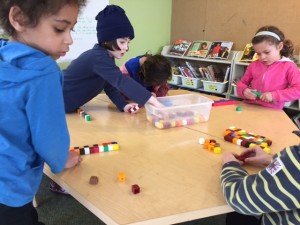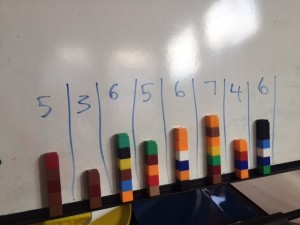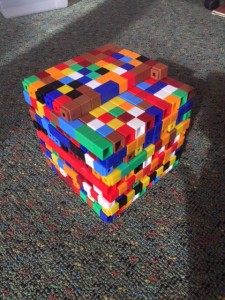Classroom Inventory in First Grade
 The overall goal of math learning at Miquon is to enable children to both understand and apply mathematics. We want them to become confident mathematical thinkers who understand why as well as how and who can see connections and continuity in their growing mathematical knowledge. Our approach to mathematics instruction is based on inquiry, discovery, reasoning, and application in many different arenas. We want children to be makers and builders of their own mathematical understanding; we want them to view mathematics as an area for play and recreation as well as a set of useful skills.
The overall goal of math learning at Miquon is to enable children to both understand and apply mathematics. We want them to become confident mathematical thinkers who understand why as well as how and who can see connections and continuity in their growing mathematical knowledge. Our approach to mathematics instruction is based on inquiry, discovery, reasoning, and application in many different arenas. We want children to be makers and builders of their own mathematical understanding; we want them to view mathematics as an area for play and recreation as well as a set of useful skills.
This week, members of the First Grade have counted many objects in our room. We have concluded that “We have a lot of things!” And there are few things we have more of than  Unifix cubes. We recently uncovered a few more and so we counted them as a class. This time, each child made bundles or “towers” of 10 and we combined them when finished.
Unifix cubes. We recently uncovered a few more and so we counted them as a class. This time, each child made bundles or “towers” of 10 and we combined them when finished.
As we were pulling cubes from the bins to form towers of 10s, we eventually ran out and often without completing our current tower. This led to loose cubes, incomplete towers. These leftovers are shown here. We worked to combine these into 10s. There were many thoughts as to how we could do this, e.g. “five and five makes 10,” “seven plus three is 10,” and “take two of the sixes and take one cube off each and then you have five plus five with two left over.” We will continue to work one combinations of 10 and grow our flexibility in decomposing and recomposing numbers.
 Here is our “super cube” or “cube of cubes.” It allows us to see what 1,000 looks like, to start thinking about place value, and we can also use it (later in the year) when we talk about 3-dimensionality vs. 2-dimensionality. As you can see it is not yet a true cube. Can you (and your child) figure out how many cubes we still need to make 1000?)
Here is our “super cube” or “cube of cubes.” It allows us to see what 1,000 looks like, to start thinking about place value, and we can also use it (later in the year) when we talk about 3-dimensionality vs. 2-dimensionality. As you can see it is not yet a true cube. Can you (and your child) figure out how many cubes we still need to make 1000?)
Read more about Math @ Miquon.